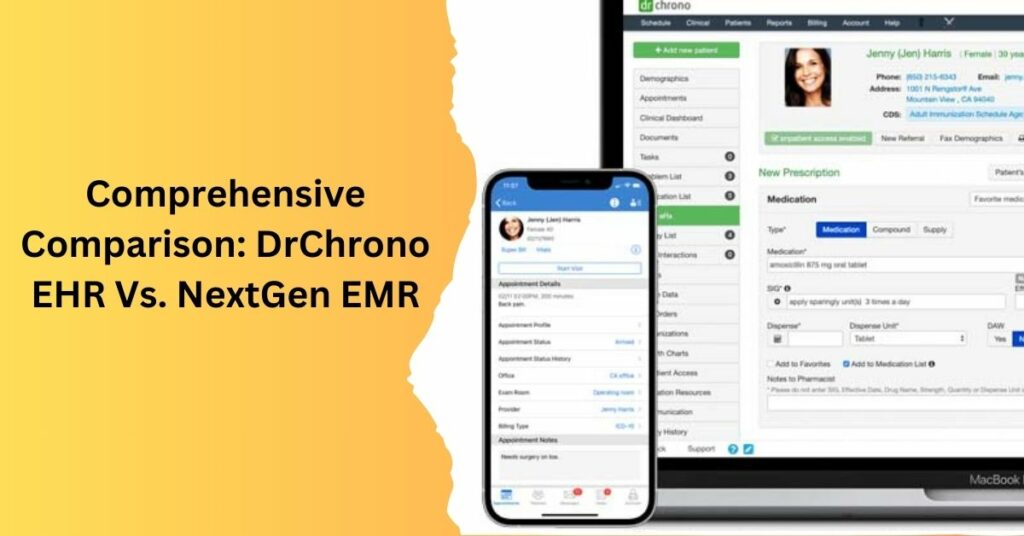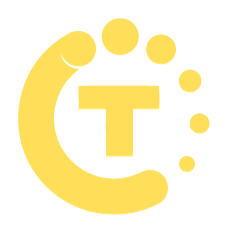Comprehensive Comparison: DrChrono EHR Vs. NextGen EMR – Which Suits Your Practice Best?

Integrating EHR and EMR technologies has transformed healthcare by expediting patient care and improving clinical procedures. In today’s digital world, healthcare practitioners, IT specialists, and clinic managers must choose the correct EHR/EMR solution.
Among the myriad options available, DrChrono EHR and NextGen EMR stand out as prominent solutions. Both systems offer unique features and functionalities, but how do they compare regarding user interface, cost, customization, and overall user satisfaction? This article aims to comprehensively compare these two leading software solutions, helping you make an informed decision that best fits the needs of your practice.
Overview Of DrChrono EHR
DrChrono EHR, a pioneer in digital healthcare, has carved out a place for itself since its launch. DrChrono is well-known for its applicability to a variety of healthcare settings. It combines versatility and creativity. This system’s key features include configurable medical forms, seamless interaction with billing and practice administration, and a patient portal for increased patient participation.
One of DrChrono’s most notable features is its easy-to-use UI. It is designed with the modern healthcare practitioner in mind and offers an intuitive experience with a short learning curve. The interface promotes speed and user-friendliness while arranging appointments, updating patient information, or processing payments.
Furthermore, DrChrono is known for its sophisticated mobile application, allowing healthcare personnel to access patient information and execute crucial activities from any location, improving overall patient care.
Overview Of NextGen EMR
NextGen EMR, a significant participant in the healthcare technology field, has been a popular choice among many healthcare providers owing to its comprehensive and integrated solutions. NextGen EMR is well-known for its scalability, making it suitable for multiple medical practices, from tiny clinics to huge healthcare organizations.
At the heart of NextGen’s products is a feature-rich platform incorporating improved clinical documentation, integrated practice management, and powerful analytics. These features aim to improve healthcare results, simplify administrative processes, and increase patient-provider communication.
NextGen EMR’s user interface is another standout. It is designed to address the challenges of current healthcare contexts. The interface reduces administrative load by allowing for rapid navigation, quick data entry, and simple access to vital patient information, maximizing patient care time.
NextGen also prioritizes interoperability, ensuring their system can link effortlessly with various healthcare IT systems, which is critical for providing a consistent healthcare experience.
Comparing User Interfaces
The user interface (UI) is a significant component of EHR/EMR systems, affecting healthcare practitioners’ efficiency and satisfaction. DrChrono and NextGen EMR provide unique UI experiences for their respective user groups.
DrChrono’s UI is well-known for its simplicity and ease of use. It has a simple, straightforward design that eliminates complexity and allows for easy navigation. Its mobile app design is particularly famous for its responsiveness and user-friendliness, making it easy for healthcare workers to manage patient care while on the road.
NextGen’s UI, on the other hand, is intended for general usage. While it has a vast range of features, this can occasionally result in a more complicated navigating experience. However, it compensates for this with configurable templates and shortcuts that may be adapted to specific provider preferences and workflows, resulting in increased productivity over time.
DrChrono provides a more basic, mobile-friendly design that is excellent for rapid and convenient access to patient data while on the go. While slightly more complex, NextGen offers a higher level of flexibility and functionality, making it ideal for various medical offices requiring thorough data management.
Cost Analysis
The cost of EHR/EMR systems is essential for healthcare providers. DrChrono and NextGen EMR have distinct price models that cater to various financial and functional requirements.
DrChrono Pricing: DrChrono has a tiered pricing scheme, with plans ranging from basic to extensive features. Pricing begins at a basic level, appropriate for smaller practices, and progresses to more comprehensive plans that include full-service revenue cycle management and advanced reporting. This flexibility allows practitioners to select a plan that fits their size and budget.
NextGen Pricing: NextGen offers a tiered pricing system. Its plans are designed to meet the diverse demands of small and big practices, with options ranging from basic EMR features to more comprehensive, integrated EHR and practice management systems. Pricing information matches the practice’s needs and size, offering a customized approach.
It’s worth noting that both systems may require additional fees for deployment, training, and continuing maintenance. When considering these systems, practices should evaluate both the base price and the total cost of ownership.
Customization Capabilities
Customization is essential in the usability of EHR/EMR systems because it allows healthcare professionals to adjust the software to their individual workflows and requirements.
DrChrono Customization: DrChrono is well-known for its customization capabilities. The system allows healthcare practitioners to build and change patient encounter templates, ensuring the software is tailored to their workflow.
Furthermore, its API access allows for additional customization and interaction with other tools and systems, giving a high level of flexibility for practices with specific needs.
NextGen Customization: NextGen EMR also provides extensive customization options. Its technology enables the customization of templates and procedures to fit different specializations and practice sizes.
NextGen’s emphasis on interoperability and integration contributes significantly to its customization options, allowing practices to interface the EMR system with other healthcare apps and systems, resulting in a more seamless and efficient workflow.
User Reviews And Feedback
User reviews and feedback are invaluable for understanding how DrChrono EHR and NextGen EMR perform in real-world settings. Here’s a summary of what users are saying:
DrChrono EHR
Users frequently complement DrChrono’s user-friendly design, especially the mobile app, which they find helpful for on-the-go access. The system’s customization options are also often mentioned, with many users enjoying the opportunity to modify the program to their requirements.
However, some users point to limits in more complex capabilities and the necessity for more robust functionality as their business expands.
Pros And Cons
Understanding the advantages and disadvantages of DrChrono EHR and NextGen EMR is essential for making an educated selection. Here is an overview of the advantages and disadvantages of each method.
Pros
· User-Friendly Interface: Ideal for quick navigation and ease of use, particularly in its mobile app.
· Customization: Offers extensive template customization, adaptable to various healthcare practices.
· Flexibility: Suitable for practices of all sizes, with a range of pricing plans.
Cons
· Limited Advanced Features: These may not offer as many complex functionalities as more significant, comprehensive systems.
· Scaling Limitations: While flexible, larger practices might have certain scalability limitations.
NextGen EMR
NextGen EMR is praised for its extensive feature set and ability to manage complicated medical processes. Its robust integration capabilities are particularly noteworthy, enabling practitioners to build a more linked healthcare IT environment. On the flip side, customers frequently point out the interface’s complexity, which can be intimidating for new users and necessitates extra time for staff training.
Pros And Cons
Pros
· Comprehensive Functionality: Offers various features suitable for complex healthcare environments.
· Customizable Workflows: Highly adaptable templates and workflows for different medical specialties.
· Strong Integration: Excellent interoperability with other healthcare systems.
Cons
· Complex Interface: The complex UI can overwhelm new users, requiring a steeper learning curve.
· Cost: It might be higher, especially for smaller practices with limited budgets.
Conclusion
The choice between DrChrono EHR and NextGen EMR is primarily determined by your healthcare practice’s demands and circumstances. DrChrono stands out for its user-friendly design and customization capabilities, making it a good solution for smaller clinics or those that value simplicity and flexibility.
NextGen EMR, on the other hand, is ideal for more extensive practices or those who want a more complete system, thanks to its broad features and excellent integration possibilities.
Finally, the selection should be made after thoroughly assessing your practice’s size, workflow difficulties, and long-term objectives. Both approaches have merits and can improve the efficiency and quality of patient treatment. We recommend comparing both systems with your unique needs to make the best decision.








